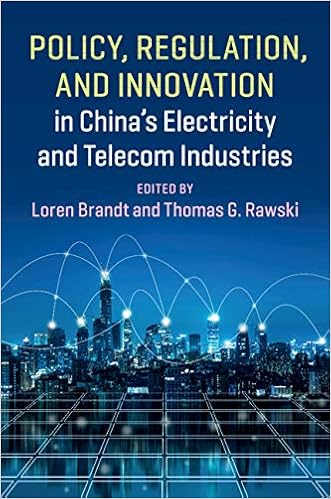Loren Brandt and Thomas Rawski, two of the best economists and economic historians working on China, have a new edited volume out under the somewhat daunting title of Policy, Regulation and Innovation in China’s Electricity and Telecom Industries. It promises to be essential reading for anyone interested in how industrial policy works in China–a topic that, thanks to the massive scale of various subsidy programs like Made in China 2025 and the US trade war that has been launched in response, is now of far more than specialist interest.
I have not yet read the book, but I did watch a September 26 event at CSIS in which Brandt and Rawski discuss their work, under the catchier title “Can China’s industrial policy work?” Sadly, if not surprisingly, the book does not provide a simple answer to that question. Here is how Rawski put it:
We have no big theory. We cannot predict which policies will produce success and which policies don’t. We see the same policies affecting the semiconductor industry, which has done very poorly, the thermal power equipment industry, which has done well, and ultra-high-voltage power transmission, which is a world leader technologically. What is the key? Perhaps it is the difficulty of the technical obstacles that these firms confront. Perhaps it is quality of management. It’s hard to say. There’s no simple way of saying what works and what doesn’t work in China’s industrial policy.
If they do not have simple answers, they do provide a lot of important insights into how China’s system, with its hybrid of market mechanisms and top-down political direction, actually works. I particularly liked the concept of “system costs” which Rawksi brings up in his very interesting discussion of the electricity industry (these are my notes from the video, lightly edited):
Another feature that we see across the board is that they prioritize technical objectives over economic objectives. I think this partly reflects the Soviet legacy. One of the lessons of this book, for me at least, is that the legacy of Soviet influence in the Chinese economy is much larger than I thought it was when we started out on this project. The objectives of the Made in China 2025 program read like the first Five-Year Plan. There’s no discussion of markets, there’s no discussion of competition–it’s about physical targets.
Another important conclusion is that this is a system that has very high built-in costs. Electricity provides a vehicle for looking at this because it’s simple: there’s one product, five firms produce half the output, two firms distribute 90% of the output. So by looking at a very small number of firms we can see what’s going on in the whole industry. We can quantify some of the system costs people like Ken Lieberthal associate with China’s “highly negotiated” political system.
Negotiation means time and energy, and to us that means system costs. In the American electricity industry, the share of managers is 6.8%; in China it’s 17.8%. You need this extra manpower to work things out. We find that the cost of generating and delivering electricity is 30% higher in China than it is in the US, even though the ingredients are cheaper in China than they are in the US.
Our authors find many areas in which technical upgrades produce no economic benefit. As one engineer at a power plant said to us: we spent a large amount of money improving our equipment to lower our coal consumption, but of course if we had just increased the utilization of the existing plant, we could have gotten the same reduction in coal consumption at zero cost. Many episodes of this sort. We find low utilization in the telecom networks, in the electricity grid. In the US, engineers recommend 15% extra capacity compared to peak load in power systems. In China, the provincial average is 90%. In Inner Mongolia, which is the biggest power generating province, it’s over 200%.
And finally, quality issues. A deputy minister says that Chinese machinery is useful but not too reliable because of small defects. In high technology industries, this is very dangerous.
So what we’re looking at is a tug of war. We see huge resources being poured into innovation, we see the creativity and entrepreneurship of the Chinese people and Chinese firms. This is good. And we see also system costs and inefficiencies which are moving in the other direction.
The Q&A also covers China’s role in the global productivity slowdown, safety in nuclear power, the use of labor in coal mining, and other interesting topics. Worth watching.

